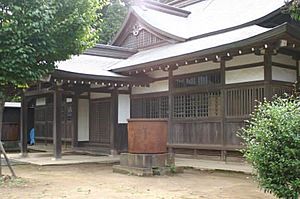Kashima-jingū facts for kids
The Kashima-jingū (鹿島神宮), also known as Kashima-jinja, is a very important Japanese Shinto shrine. You can find it in Kashima, Ibaraki on the island of Honshu. This special place is dedicated to a powerful kami (spirit or deity) named Takemikazuchi no ookami (武甕槌大神).
Contents
A Look Back in Time
Kashima-jingū has a long and interesting history. Long ago, it was known as the main Shinto shrine, or ichinomiya, for the old Hitachi Province. Think of an ichinomiya as the most important shrine in a certain area. Today, it still holds this special title for Ibaraki Prefecture.
In the past, Kashima-jingū was considered one of the most respected imperial shrines. It was part of a group called Kanpei-chūsha (官幣中社), which included 23 highly honored sanctuaries. This shows just how important Kashima-jingū has been throughout Japan's history.
Understanding Shinto Shrines
Shinto is the traditional religion of Japan. Shinto shrines like Kashima-jingū are sacred places where people go to worship kami. These kami are spirits or gods that can be found in nature, like mountains or rivers, or they can be spirits of important people. People visit shrines to offer prayers, ask for good fortune, and show respect.
The Kami of Kashima-jingū
The main kami honored at Kashima-jingū is Takemikazuchi no ookami (武甕槌大神). This kami is known as a god of thunder, swords, and martial arts. Because of this, Kashima-jingū has been a special place for warriors and martial artists for centuries. Many people still visit the shrine today to pray for strength and success.
What You Might See at Kashima-jingū
When you visit Kashima-jingū, you'll see many interesting things. Like most Shinto shrines, it has large torii gates at its entrance. These gates mark the boundary between the everyday world and the sacred space of the shrine. You'll also find beautiful buildings, including the main hall where the kami is enshrined. The shrine grounds are often surrounded by peaceful forests, and you might even see some deer, which are considered messengers of the kami.


